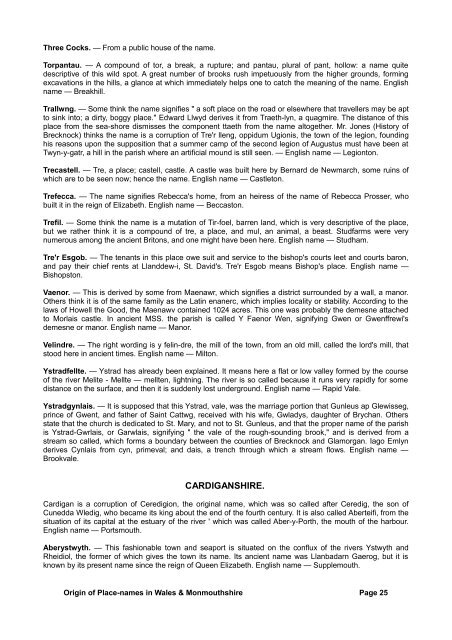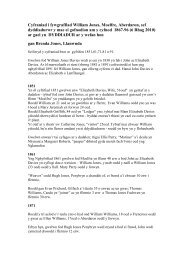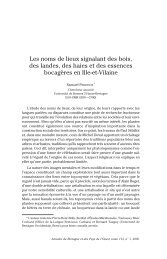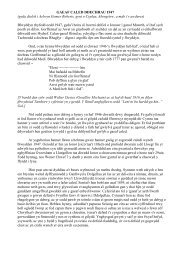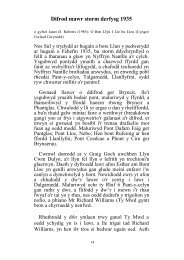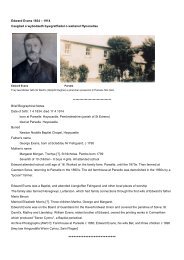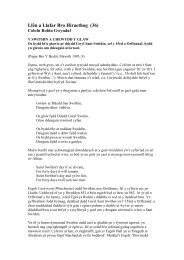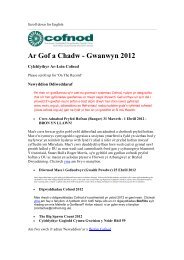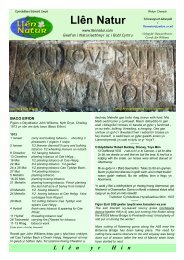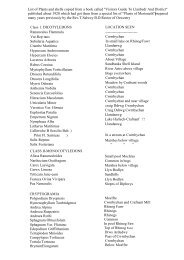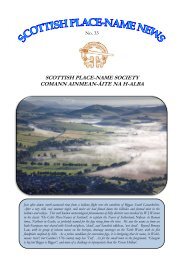Three Cocks. — From a public house <strong>of</strong> <strong>the</strong> name.Torpantau. — A compound <strong>of</strong> tor, a break, a rupture; <strong>and</strong> pantau, plural <strong>of</strong> pant, hollow: a name quitedescriptive <strong>of</strong> this wild spot. A great number <strong>of</strong> brooks rush impetuously from <strong>the</strong> higher grounds, form<strong>in</strong>gexcavations <strong>in</strong> <strong>the</strong> hills, a glance at which immediately helps one to catch <strong>the</strong> mean<strong>in</strong>g <strong>of</strong> <strong>the</strong> name. Englishname — Breakhill.Trallwng. — Some th<strong>in</strong>k <strong>the</strong> name signifies " a s<strong>of</strong>t <strong>place</strong> on <strong>the</strong> road or elsewhere that travellers may be aptto s<strong>in</strong>k <strong>in</strong>to; a dirty, boggy <strong>place</strong>." Edward Llwyd derives it from Traeth-lyn, a quagmire. The distance <strong>of</strong> this<strong>place</strong> from <strong>the</strong> sea-shore dismisses <strong>the</strong> component ttaeth from <strong>the</strong> name altoge<strong>the</strong>r. Mr. Jones (History <strong>of</strong>Brecknock) th<strong>in</strong>ks <strong>the</strong> name is a corruption <strong>of</strong> Tre'r lleng, oppidum Ugionis, <strong>the</strong> town <strong>of</strong> <strong>the</strong> legion, found<strong>in</strong>ghis reasons upon <strong>the</strong> supposition that a summer camp <strong>of</strong> <strong>the</strong> second legion <strong>of</strong> Augustus must have been atTwyn-y-gatr, a hill <strong>in</strong> <strong>the</strong> parish where an artificial mound is still seen. — English name — Legionton.Trecastell. — Tre, a <strong>place</strong>; castell, castle. A castle was built here by Bernard de Newmarch, some ru<strong>in</strong>s <strong>of</strong>which are to be seen now; hence <strong>the</strong> name. English name — Castleton.Trefecca. — The name signifies Rebecca's home, from an heiress <strong>of</strong> <strong>the</strong> name <strong>of</strong> Rebecca Prosser, whobuilt it <strong>in</strong> <strong>the</strong> reign <strong>of</strong> Elizabeth. English name — Beccaston.Trefil. — Some th<strong>in</strong>k <strong>the</strong> name is a mutation <strong>of</strong> Tir-foel, barren l<strong>and</strong>, which is very descriptive <strong>of</strong> <strong>the</strong> <strong>place</strong>,but we ra<strong>the</strong>r th<strong>in</strong>k it is a compound <strong>of</strong> tre, a <strong>place</strong>, <strong>and</strong> mul, an animal, a beast. Studfarms were verynumerous among <strong>the</strong> ancient Britons, <strong>and</strong> one might have been here. English name — Studham.Tre'r Esgob. — The tenants <strong>in</strong> this <strong>place</strong> owe suit <strong>and</strong> service to <strong>the</strong> bishop's courts leet <strong>and</strong> courts baron,<strong>and</strong> pay <strong>the</strong>ir chief rents at Ll<strong>and</strong>dew-i, St. David's. Tre'r Esgob means Bishop's <strong>place</strong>. English name —Bishopston.Vaenor. — This is derived by some from Maenawr, which signifies a district surrounded by a wall, a manor.O<strong>the</strong>rs th<strong>in</strong>k it is <strong>of</strong> <strong>the</strong> same family as <strong>the</strong> Lat<strong>in</strong> enanerc, which implies locality or stability. Accord<strong>in</strong>g to <strong>the</strong>laws <strong>of</strong> Howell <strong>the</strong> Good, <strong>the</strong> Maenawv conta<strong>in</strong>ed 1024 acres. This one was probably <strong>the</strong> demesne attachedto Morlais castle. In ancient MSS. <strong>the</strong> parish is called Y Faenor Wen, signify<strong>in</strong>g Gwen or Gwenffrewi'sdemesne or manor. English name — Manor.Vel<strong>in</strong>dre. — The right word<strong>in</strong>g is y fel<strong>in</strong>-dre, <strong>the</strong> mill <strong>of</strong> <strong>the</strong> town, from an old mill, called <strong>the</strong> lord's mill, thatstood here <strong>in</strong> ancient times. English name — Milton.Ystradfellte. — Ystrad has already been expla<strong>in</strong>ed. It means here a flat or low valley formed by <strong>the</strong> course<strong>of</strong> <strong>the</strong> river Melite - Mellte — mellten, lightn<strong>in</strong>g. The river is so called because it runs very rapidly for somedistance on <strong>the</strong> surface, <strong>and</strong> <strong>the</strong>n it is suddenly lost underground. English name — Rapid Vale.Ystradgynlais. — It is supposed that this Ystrad, vale, was <strong>the</strong> marriage portion that Gunleus ap Glewisseg,pr<strong>in</strong>ce <strong>of</strong> Gwent, <strong>and</strong> fa<strong>the</strong>r <strong>of</strong> Sa<strong>in</strong>t Cattwg, received with his wife, Gwladys, daughter <strong>of</strong> Brychan. O<strong>the</strong>rsstate that <strong>the</strong> church is dedicated to St. Mary, <strong>and</strong> not to St. Gunleus, <strong>and</strong> that <strong>the</strong> proper name <strong>of</strong> <strong>the</strong> parishis Ystrad-Gwrlais, or Garwlais, signify<strong>in</strong>g " <strong>the</strong> vale <strong>of</strong> <strong>the</strong> rough-sound<strong>in</strong>g brook," <strong>and</strong> is derived from astream so called, which forms a boundary between <strong>the</strong> counties <strong>of</strong> Brecknock <strong>and</strong> Glamorgan. Iago Emlynderives Cynlais from cyn, primeval; <strong>and</strong> dais, a trench through which a stream flows. English name —Brookvale.CARDIGANSHIRE.Cardigan is a corruption <strong>of</strong> Ceredigion, <strong>the</strong> <strong>orig<strong>in</strong></strong>al name, which was so called after Ceredig, <strong>the</strong> son <strong>of</strong>Cunedda Wledig, who became its k<strong>in</strong>g about <strong>the</strong> end <strong>of</strong> <strong>the</strong> fourth century. It is also called Aberteifi, from <strong>the</strong>situation <strong>of</strong> its capital at <strong>the</strong> estuary <strong>of</strong> <strong>the</strong> river ' which was called Aber-y-Porth, <strong>the</strong> mouth <strong>of</strong> <strong>the</strong> harbour.English name — Portsmouth.Aberystwyth. — This fashionable town <strong>and</strong> seaport is situated on <strong>the</strong> conflux <strong>of</strong> <strong>the</strong> rivers Ystwyth <strong>and</strong>Rheidiol, <strong>the</strong> former <strong>of</strong> which gives <strong>the</strong> town its name. Its ancient name was Llanbadarn Gaerog, but it isknown by its present name s<strong>in</strong>ce <strong>the</strong> reign <strong>of</strong> Queen Elizabeth. English name — Supplemouth.Orig<strong>in</strong> <strong>of</strong> Place-<strong>names</strong> <strong>in</strong> Wales & Monmouthshire Page 25
Ardudwy. — Ar, upon or above; tud, soil, l<strong>and</strong>; wy y water; literally, on <strong>the</strong> l<strong>and</strong> or banks <strong>of</strong> <strong>the</strong> Wye.Accord<strong>in</strong>g to Dr. Pughe, <strong>the</strong> name means a " maritime region." English name — Waterby'.Argoed. — Ar-ard, signify<strong>in</strong>g height; coed, trees. The name signifies a <strong>place</strong> sheltered by woods. Englishname — Highwood.Atpar. — Probably an Anglicized form <strong>of</strong> At-bar, which means towards <strong>the</strong> top <strong>of</strong> <strong>the</strong> hill. The village is alsocalled Trefhedyn, which is probably a corruption <strong>of</strong> Tref-y-d<strong>in</strong> - hill-town. English name — Hillham.Bettws-Bledrws. — Bettws has already been expla<strong>in</strong>ed. The church is dedicated to St. Bledrws; hence <strong>the</strong>name. English name — Bledrws.Bettws I fan. — The church is dedicated to St. John. I fan or Ieuan is an old Welsh form <strong>of</strong> loan, John.English name— John's Church.Blaencaron. — This <strong>place</strong> is situated near <strong>the</strong> source <strong>of</strong> <strong>the</strong> river Caron ; hence <strong>the</strong> name. English name —Caronton.Blaenhownant. — This rivulet is called Hownant, which is a corruption <strong>of</strong> hoyw, lively; <strong>and</strong> nant, brook; <strong>and</strong><strong>the</strong> <strong>place</strong> was so called from its situation near <strong>the</strong> source <strong>of</strong> <strong>the</strong> Hownant. English name— Sprightham.Brechfa. — A compound <strong>of</strong> breck, br<strong>in</strong>dled, freckled, <strong>and</strong> man, a <strong>place</strong>. It is supposed that Brychan, whocame <strong>orig<strong>in</strong></strong>ally from Irel<strong>and</strong>, <strong>and</strong> settled <strong>in</strong> Breconshire <strong>in</strong> <strong>the</strong> sixth century, was so called from his be<strong>in</strong>gfreckled. English name — Freckleton or Spotham.Brongest. — Bron, a slope, or side <strong>of</strong> a hill; literally, breast. Cest, a deep glen between two mounta<strong>in</strong>s. Thename is quite descriptive <strong>of</strong> <strong>the</strong> situation <strong>of</strong> <strong>the</strong> <strong>place</strong>. English name — Hillcombe.Brongwyn. — A parish <strong>in</strong> Cardigan <strong>and</strong> Pembroke counties. Some are <strong>of</strong> op<strong>in</strong>ion that this name is a relic <strong>of</strong><strong>the</strong> Druids, to whose system belonged Ceryg y Bryn Gwyn, i.e., <strong>the</strong> stones <strong>of</strong> <strong>the</strong> hill <strong>of</strong> judicature. If so, <strong>the</strong>prefix bron here is a corruption <strong>of</strong> bryn, a hill. English name — Whitehill.Bwlchcrwys. — Bwlch, a break or breach, a gap, a defile; crwys, a corrupt form <strong>of</strong> croes, a cross. The nameBwlch-y-groes is <strong>of</strong> frequent occurrence <strong>in</strong> <strong>the</strong> Pr<strong>in</strong>cipality. We have many <strong>in</strong>stances <strong>of</strong> croes be<strong>in</strong>g changedto crwys, Y Crwys, Pantycrwys <strong>and</strong> Bwlch-y -crwys, &c. " Dan ei gtwys," under <strong>the</strong> cross, is a phrase evennow frequently used <strong>in</strong> Wales <strong>in</strong> reference to <strong>the</strong> posture <strong>of</strong> a dead body before it is put <strong>in</strong>to <strong>the</strong> c<strong>of</strong>f<strong>in</strong>. InPopish times it was customary to put a cross or a crucifix on a dead body ly<strong>in</strong>g <strong>in</strong> its shroud; but now,although <strong>the</strong> phrase is occasionally heard, <strong>the</strong> usage <strong>of</strong> this Popish relic has been entirely ab<strong>and</strong>onedamong <strong>the</strong> Welsh people. Many Welsh <strong>place</strong>s still reta<strong>in</strong> <strong>the</strong> name, among which is Bwlchcrwys. It wascustomary <strong>in</strong> olden times for pilgrims to prostrate <strong>the</strong>mselves at certa<strong>in</strong> passes to <strong>in</strong>voke <strong>the</strong> bless<strong>in</strong>gs <strong>of</strong> <strong>the</strong>Cross before go<strong>in</strong>g through; hence <strong>the</strong> name Bwlchcrwys or Bwlchygroes. English name — Passcross.Capel Gwndwn. — Capel, chapel ; Gwndwn, is a compound <strong>of</strong> cwn, a head, top, summit; <strong>and</strong> twyn, ahillock. The name signifies a chapel built on an em<strong>in</strong>ence. — English name— Highchapel.Capel y Dr<strong>in</strong>dod. — This village probably derives its name from a Welsh Calv<strong>in</strong>istic Methodist chapel <strong>of</strong> <strong>the</strong>name. English name— Tr<strong>in</strong>ity Chapel.Ce<strong>in</strong>ewydd. — A hybrid name made up <strong>of</strong> quay, from French quai, a mole or bank formed toward <strong>the</strong> sea oron <strong>the</strong> side <strong>of</strong> a river for <strong>the</strong> purpose <strong>of</strong> load<strong>in</strong>g <strong>and</strong> unload<strong>in</strong>g vessels; <strong>and</strong> newydd, new. Or perhaps <strong>the</strong>prefix comes from cae, an <strong>in</strong>closure. English name — New Quay.Cellan. — The name <strong>of</strong> this parish is a compound <strong>of</strong> cell, a shelter<strong>in</strong>g <strong>place</strong>, a grove; <strong>and</strong> llan, a church,signify<strong>in</strong>g a church <strong>in</strong> a grove. English name — Grovechurch.Cenarth. — Some ma<strong>in</strong>ta<strong>in</strong> that <strong>the</strong> right word<strong>in</strong>g is Genarth, <strong>the</strong> bear's jaw. Tradition has it that <strong>the</strong> jawbone<strong>of</strong> a bear was found <strong>in</strong> <strong>the</strong> <strong>place</strong>, <strong>and</strong> its head <strong>in</strong> Penarth. Penarth, as we show elsewhere, is Penygarth, <strong>and</strong> we are <strong>in</strong>cl<strong>in</strong>ed to th<strong>in</strong>k Cenarth is a compound <strong>of</strong> cefn, ridge, back; <strong>and</strong> garth, a fort, a hill, acape. The name is a graphic description <strong>of</strong> <strong>the</strong> <strong>place</strong>, be<strong>in</strong>g perched on a high ridge, ever watch<strong>in</strong>g <strong>the</strong>graceful movements <strong>of</strong> <strong>the</strong> Teivi. English name — Ridgeham.Orig<strong>in</strong> <strong>of</strong> Place-<strong>names</strong> <strong>in</strong> Wales & Monmouthshire Page 26
- Page 1 and 2: HANDBOOK OF THE ORIGIN OF PLACE-NAM
- Page 3 and 4: § § § § §The Author begs to st
- Page 5 and 6: pitiful cries of the railway offici
- Page 7 and 8: Bishop Percy says that "in England,
- Page 9 and 10: The city of Chester is still popula
- Page 11 and 12: There's Cumwhitton, Cumwhinton, Cum
- Page 13 and 14: Llwyn in its primary' sense means a
- Page 15 and 16: PLACE-NAMES IN WALES.Wales. — The
- Page 17 and 18: Church are generally dedicated to e
- Page 19 and 20: think he was a contemporary of St.
- Page 21 and 22: Rhosbeirio. — Rhos, a moor, a dry
- Page 23 and 24: of Brecknock," states that this vic
- Page 25 and 26: Cam cnwir ef Cwmdu,Cwm gwyn yw & n
- Page 27: Penderyn. — A corruption probably
- Page 31 and 32: to mark its pre-eminence over the o
- Page 33 and 34: Some think that eirw is a corruptio
- Page 35 and 36: present form — Caerfyrddin.Abergw
- Page 37 and 38: place of refuge; hence the name. En
- Page 39 and 40: Llansawyl. — The church was dedic
- Page 41 and 42: eject. The village took its name fr
- Page 43 and 44: house, and attempted to kill an inf
- Page 45 and 46: Gwydir. — Prima facie one may tak
- Page 47 and 48: Nefyn. — The church was probably
- Page 49 and 50: DENBIGHSHIRE.Anglicized form of Din
- Page 51 and 52: Llangollen. — From Collen, a sain
- Page 53 and 54: hands into their pockets to pay a c
- Page 55 and 56: Cefn. — The name signifies a ridg
- Page 57 and 58: Maesgarmon. — Named in honour of
- Page 59 and 60: Abertridwr. — Tridwr, three water
- Page 61 and 62: it is said, was originally built by
- Page 63 and 64: Cwmllynfell. — Cwm, a narrow vale
- Page 65 and 66: Gwarycaeau. — Gwdr, the nape of t
- Page 67 and 68: means a cultivated region, a vale,
- Page 69 and 70: Penrhiwfer.- Pen, head, top; rhiw,
- Page 71 and 72: Port Talbot. — So called in 1835
- Page 73 and 74: Trealaw. — This appellation was g
- Page 75 and 76: Aberdyfi. — So called from its si
- Page 77 and 78: Llanddwywe. — From Dwywau, a desc
- Page 79 and 80:
Crickhowell and some in the directi
- Page 81 and 82:
Griffithstown. — This village was
- Page 83 and 84:
and gwy, water. Treiddiod troth tna
- Page 85 and 86:
derive Tintern from din, fortified
- Page 87 and 88:
Caersws. — It appears that the Ro
- Page 89 and 90:
English name — Ervylton.Llanymech
- Page 91 and 92:
Angle. — Probably from the angle-
- Page 93 and 94:
Gellyswick. — Another hybrid. Gel
- Page 95 and 96:
that the two rivers in their flowin
- Page 97 and 98:
ecame the bishop of the see, and wa
- Page 99 and 100:
earth formerly stood on a summit on
- Page 101 and 102:
Pilleth. — A corruption of pwll,
- Page 103 and 104:
Howells, Rev. J., Mountain AshHowel
- Page 105 and 106:
Williams, D., PenywernWilliams, Rev


